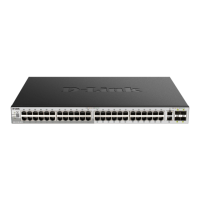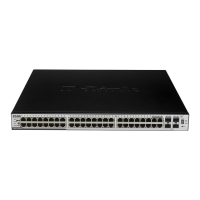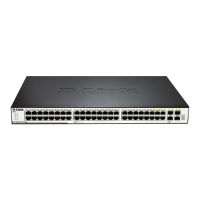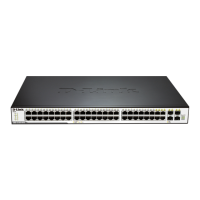DGS-3130 Series Layer 3 Stackable Managed Switch Web UI Reference Guide
132
Parameter Description
802.1P Priority Select the 802.1p priority value here. The range is from 0 to 7. A higher value
has a higher priority.
New Inner VID After selecting Dot1q-Tunnel as the action, enter the new inner VLAN ID here.
The range is from 1 to 4094. This option is only available when Dot1q-Tunnel
was selected as the action.
Click the Back button to return to the previous window.
Click the Apply button to accept the changes made.
STP
This Switch supports three versions of the Spanning Tree Protocol (STP): IEEE 802.1D-1998 STP, IEEE 802.1D-2004
Rapid STP, and IEEE 802.1Q-2005 MSTP. The IEEE 802.1D-1998 STP standard will be familiar to most networking
professionals. However, as IEEE 802.1D-2004 RSTP and IEEE 802.1Q-2005 MSTP have been recently introduced to
D-Link managed Ethernet Switches, a brief introduction to the technology is provided below followed by a description
of how to set up IEEE 802.1D-1998 STP, IEEE 802.1D-2004 RSTP, and IEEE 802.1Q-2005 MSTP.
802.1Q-2005 MSTP
The Multiple Spanning Tree Protocol (MSTP) is a standard defined by the IEEE community that allows multiple VLANs
to be mapped to a single spanning tree instance, which will provide multiple pathways across the network. Therefore,
these MSTP configurations will balance the traffic load, preventing wide scale disruptions when a single spanning tree
instance fails. This will allow for faster convergences of new topologies for the failed instance.
Frames designated for these VLANs will be processed quickly and completely throughout interconnected bridges
utilizing any of the three spanning tree protocols (STP, RSTP or MSTP).
A Multiple Spanning Tree Instance (MSTI) ID will classify these instances. MSTP will connect multiple spanning trees
with a Common and Internal Spanning Tree (CIST). The CIST will automatically determine each MSTP region, its
maximum possible extent and will appear as one virtual bridge that runs a single spanning tree instance. Frames
assigned to different VLANs will follow different data routes within administratively established regions on the network,
continuing to allow simple and full processing of frames, regardless of administrative errors in defining VLANs and
their respective spanning trees.
Each Switch utilizing the MSTP on a network will share a single MSTP configuration that will have the following three
attributes:
• A configuration name defined by an alphanumeric string of up to 32 characters (defined in the MST
Configuration Identification window in the Configuration Name field).
• A configuration revision number (named here as a Revision Level and found in the MST Configuration
Identification window)
• A 4094-element table (defined here as a VID List in the MST Configuration Identification window), which will
associate each of the possible 4094 VLANs supported by the Switch for a given instance.
To utilize the MSTP function on the Switch, three steps need to be taken:
• The Switch must be set to the MSTP setting (found in the STP Global Settings window in the STP Mode field).
• The correct spanning tree priority for the MSTP instance must be entered (defined here as a Priority in the
MSTP Port Information window when configuring MSTI ID settings).
• VLANs that will be shared must be added to the MSTP Instance ID (defined here as a VID List in the MST
Configuration Identification window when configuring an MSTI ID settings).
802.1D-2004 Rapid Spanning Tree

